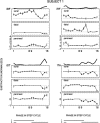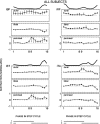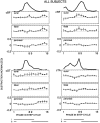Dynamic control of location-specific information in tactile cutaneous reflexes from the foot during human walking
- PMID: 9133399
- PMCID: PMC6573668
- DOI: 10.1523/JNEUROSCI.17-10-03804.1997
Dynamic control of location-specific information in tactile cutaneous reflexes from the foot during human walking
Abstract
The purpose of the present study was to determine whether tactile cutaneous reflexes from the skin of the foot contain location-specific information during human walking. Muscular responses to non-nociceptive electrical stimulation of the sural, posterior tibial, and superficial peroneal nerves, each supplying a different skin area of the foot, were studied in both legs during walking on a treadmill. For all three nerves the major responses in all muscles were observed at a similar latency of approximately 80-85 msec. In the ipsilateral leg these reflex responses and their phase-dependent modulation were highly nerve-specific. During most of the stance phase, for example, the peroneal and tibial nerves generally evoked small responses in the biceps femoris muscle. In contrast, during late swing large facilitations generally occurred for the peroneal nerve, whereas suppressions were observed for the tibial nerve. In the contralateral leg the reflex responses for the three nerves were less distinct, although some nerve specificity was observed for individual subjects. It is concluded that non-nociceptive stimulation of the sural, posterior tibial, and superficial peroneal nerves each evokes distinct reflex responses, indicating the presence of location-specific information from the skin of the foot in cutaneous reflexes during human walking. It will be argued that differentially controlled reflex pathways can account for the differences in the phase-dependent reflex modulation patterns of the three nerves, which points to the dynamic control of this information during the course of a step cycle.
Figures






Similar articles
-
Postural uncertainty leads to dynamic control of cutaneous reflexes from the foot during human walking.Brain Res. 2005 Nov 16;1062(1-2):48-62. doi: 10.1016/j.brainres.2005.09.003. Epub 2005 Oct 24. Brain Res. 2005. PMID: 16248988 Clinical Trial.
-
Regionally distinct cutaneous afferent populations contribute to reflex modulation evoked by stimulation of the tibial nerve during walking.J Neurophysiol. 2016 Jul 1;116(1):183-90. doi: 10.1152/jn.01011.2015. Epub 2016 Apr 13. J Neurophysiol. 2016. PMID: 27075541 Free PMC article.
-
Absence of nerve specificity in human cutaneous reflexes during standing.Exp Brain Res. 2000 Jul;133(2):267-72. doi: 10.1007/s002210000411. Exp Brain Res. 2000. PMID: 10968228
-
Contributions to the understanding of gait control.Dan Med J. 2014 Apr;61(4):B4823. Dan Med J. 2014. PMID: 24814597 Review.
-
Peripheral Nerve Stimulation for the 21st Century: Sural, Superficial Peroneal, and Tibial Nerves.Pain Med. 2020 Aug 1;21(Suppl 1):S64-S67. doi: 10.1093/pm/pnaa202. Pain Med. 2020. PMID: 32804232 Review.
Cited by
-
Dynamic primitives in the control of locomotion.Front Comput Neurosci. 2013 Jun 21;7:71. doi: 10.3389/fncom.2013.00071. eCollection 2013. Front Comput Neurosci. 2013. PMID: 23801959 Free PMC article.
-
Non-ideal behavior of a treadmill depends on gait phase, speed, and weight.Sci Rep. 2019 Sep 4;9(1):12755. doi: 10.1038/s41598-019-49272-0. Sci Rep. 2019. PMID: 31484975 Free PMC article.
-
Neural control of rhythmic, cyclical human arm movement: task dependency, nerve specificity and phase modulation of cutaneous reflexes.J Physiol. 2001 Dec 15;537(Pt 3):1033-45. doi: 10.1111/j.1469-7793.2001.01033.x. J Physiol. 2001. PMID: 11744775 Free PMC article.
-
Stimulation of the dorsal root ganglion using an Injectrode®.J Neural Eng. 2021 Nov 4;18(5):10.1088/1741-2552/ac2ffb. doi: 10.1088/1741-2552/ac2ffb. J Neural Eng. 2021. PMID: 34650008 Free PMC article.
-
Two-stage muscle activity responses in decisions about leg movement adjustments during trip recovery.J Neurophysiol. 2016 Jan 1;115(1):143-56. doi: 10.1152/jn.00263.2015. Epub 2015 Nov 11. J Neurophysiol. 2016. PMID: 26561597 Free PMC article.
References
-
- Abraham LD, Marks WB, Loeb GE. The distal hindlimb musculature of the cat. Cutaneous reflexes during locomotion. Exp Brain Res. 1985;58:594–603. - PubMed
-
- Aniss AM, Gandevia SC, Burke D. Reflex changes in muscle spindle discharge during a voluntary contraction. J Neurophysiol. 1988;59:908–921. - PubMed
-
- Aniss AM, Gandevia SC, Burke D. Reflex responses in active muscles elicited by stimulation of low-threshold afferents from the human foot. J Neurophysiol. 1992;67:1375–1384. - PubMed
-
- Baker SN, Lemon RN. Non-linear summation of responses in averages of rectified EMG. J Neurosci Methods. 1995;59:175–181. - PubMed
-
- Buford JA, Smith JL. Adaptive control for backward quadrupedal walking. III. Stumbling corrective reactions and cutaneous reflex sensitivity. J Neurophysiol. 1993;70:1102–1114. - PubMed
Publication types
MeSH terms
LinkOut - more resources
Full Text Sources
Other Literature Sources
Medical
